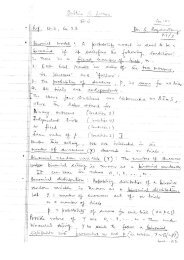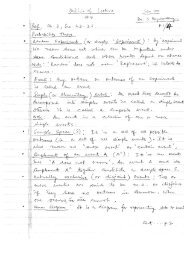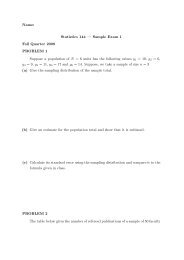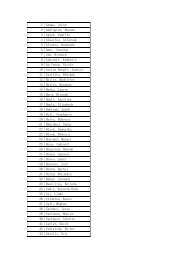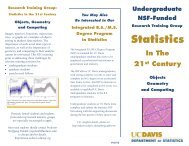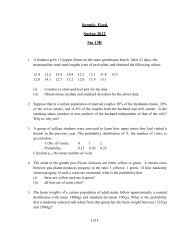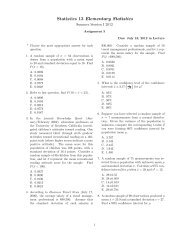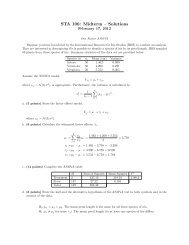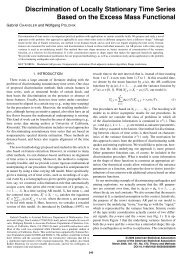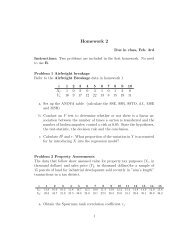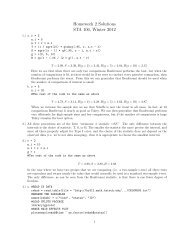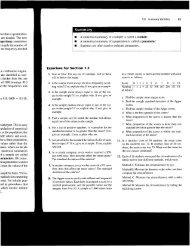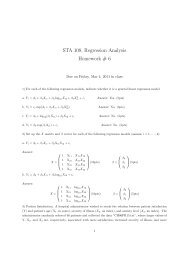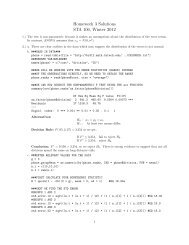HW3 - Statistics
HW3 - Statistics
HW3 - Statistics
You also want an ePaper? Increase the reach of your titles
YUMPU automatically turns print PDFs into web optimized ePapers that Google loves.
150 Part One Simple Linear Regression<br />
*3.13. Refer to Copier maintenance Problem.-I .20.<br />
- -- ___L<br />
a. What are the alternative conclusions when testing for lack of fit of a linear regression<br />
function?<br />
b. Perform the test indicated in part (a). Control the risk of Type I error at .05. State the decision<br />
rule and conclusion.<br />
c. Does the test in part (b) detect other departures from regression model (2.1), such as lack<br />
of constant variance or lack of normality in the error terms? Could the results of the test of<br />
lack of fit be affected by such departures? Discuss.<br />
function; use a = .O1. State the alternatives, decision rule, and conclusion.<br />
b. Is there any advantage of having an equal number of replications at each of the X levels? Is<br />
there any disadvantage? -<br />
c. Does the test in part (a) indicate what regression function is appropriate when it leads to the<br />
conclusion that the regression function is not linear? How would you proceed?<br />
3.1 5. Solution concentration. A chemist studied the concentration of a solution (Y) over time (X).<br />
Fifteen identical solutions were prepared. The 15 solutions were randomly divided into five<br />
sets of three, and the five sets were measured, respectively, after 1, 3, 5, 7, and 9 hours. The<br />
results follow.<br />
3 ... 13<br />
Yi: .07 .09 .08 ... 2.84 2.57 3.10<br />
a. Fit a linear regression function.<br />
function; use a = .025. State the alternatives, decision rule, and conclusion.<br />
c. Does the test in part (b) indicate what regression function is appropriate when it leads to t<br />
conclusion that lack of fit of a linear regression function exists? Explain.<br />
3.16. Refer to Solution concentration Problem 3.1 5.<br />
a. Prepare a scatter plot of the data. What transformation of Y might you try, using the prototy<br />
patterns in Figure 3.1 5 to achieve constant variance and linearity?<br />
suggested?<br />
c. Use the transformation Y' = log,, Y and obtain the estimated linear regression function<br />
the transformed data.<br />
to be a good fit to the transformed data?<br />
plot. What do your plots show?<br />
f. Express the estimated regression function in the original units.
172 Part One Simple Linear Regression<br />
ReferenceS<br />
4.1. Miller, R. G., Jr. Simultaneous Statistical Inference. 2nd ed. New York: Springer-Verlag. 1991<br />
4.2. Fuller, W. A. Measurement Error Models. New York: John Wiley & Sons, 1987.<br />
4.3. Berkson, J. "Are There Two Regressions?" Journal of the American Statistical Association 45<br />
(1 950), pp. 164-80.<br />
4.4. Cox, D. R. Planning of Experiments. New York: John Wiley & Sons, 1958, pp. 141-42.<br />
Problems 4.1. When joint confidence intervals for Bo and 8, are developed by the Bonferroni method<br />
a family confidence coefficient of 90 percent, does this imply that 10 percent of the time th<br />
confidence interval for Bo will be incorrect? That 5 percent of the time the confidence interv<br />
for Do will be incorrect and 5 percent of the time that for B1 will be incorrect? Discuss.<br />
4.2. Refer to Problem 2.1. Suppose the student combines the two confidence intervals into a con<br />
dence set. What can you say about the family confidence coefficient for this set?<br />
*4.3. Refer to Copier maintenance Problem 1.20.<br />
a. Will bo and bl tend to err in the same direction or in opposite directions here? Explain.<br />
b. Obtain Bonferroni joint confidence intervals for Bo and B,, using a 95 percent family conti.<br />
dence coefficient.<br />
c. A consultant has suggested that Bo should be 0 and BI should equal 14.0. Do your join1<br />
confidence intervals in part (b) support this view?<br />
*4.4. Refer to Airfreight breakage Problem 1.21.<br />
a. Will bo and bl tend to err in the same direction or in opposite directions here? Explain.<br />
b. Obtain Bonferroni joint confidence intervals for Po and BI, using a 99 percent family co<br />
dence coefficient. Interpret your confidence intervals.<br />
a. Obtain Bonferroni joint confidence intervals for Do and PI, using a 90 percent family co<br />
fidence coefficient. lnterpret your confidence intervals.<br />
b. Are bo and bl positively or negatively correlated here? Is this reflected in your joint con<br />
dence intervals in part (a)?<br />
c. What is the meaning of the family confidence coefficient in part (a)?<br />
*4.6. Refer to Muscle mass Problem 1.27.<br />
a. Obtain Bonferroni joint confidence intervals for Bo and PI, using a 99 percent family contl-<br />
dence coefficient, lnterpret your confidence intervals.<br />
b. Will bo and bl tend to err in the same direction or in opposite directions here? Explain.<br />
c. A researcher has suggested that Po should equal approximately 160 and that Bl should<br />
between - 1.9 and - 1.5. Do thejoint confidence intervals in part (a) support this expectatio<br />
*4.7. Refer to Copier maintenance Problem 1.20.<br />
a. Estimate the expected number of minutes spent when there are 3, 5, and 7 copiers to<br />
serviced, respectively. Use interval estimates with a 90 percent family confidence coefficicrd<br />
based on the Working-Hotelling procedure.<br />
b. Two service calls for preventive maintenance are scheduled in which the numbers of copien<br />
to be serviced are 4 and 7, respectively. A family of prediction intervals for the times 1<br />
procedure., Scheffk or Bonferroni, will provide tighter prediction limits here?<br />
c. Obtain the family of prediction intervals required in part (b), using the more efficid<br />
procedure.
Chapter 4 Simultaneous Inferences and Other Topics in Regression Analysis 173<br />
*4.8. Refer to Airfreight breakage Problem I .2 I.<br />
a. It is desired to obtain interval estimates of the mean number of broken ampules when there<br />
are 0, I, and 2 transfers for a shipment, using a 95 percent family confidence coefficient.<br />
Obtain the desired confidence intervals, using the Working-Hotelling procedure.<br />
b. Are the confidence intervals obtained in part (a) more efficient than Bonferroni intervals<br />
here? Explain.<br />
c. The next three shipments will make 0, I, and 2 transfers, respectively. Obtain prediction<br />
intervals for the number of broken ampules for each of these three shipments, using the<br />
Scheffi5 procedure and a 95 percent family confidence coefficient.<br />
d. Would the Bonferroni procedure have been more efficient in developing the prediction<br />
intervals in part (c)? Explain.<br />
to Plastic hardness Problem 1.22.<br />
a. Management wishes to obtain interval estimates of the mean hardness when the elapsed time<br />
is 20, 30, and 40 hours, respectively. Calculate the desired confidence intervals, using the<br />
Bonferroni procedure and a 90 percent family confidence coefficient. What is the meaning<br />
of the family confidence coefficient here?<br />
b. Is the Bonferroni procedure employed in part (a) the most efficient one that could be<br />
employed here? Explain.<br />
c. The next two test items will be measured after 30 and 40 hours ofelapsed time, respectively.<br />
Predict the hardness for each of these two items, using the most efficient procedure and a<br />
, 90 percent family confidence coefficient.<br />
-$4.10. Refer to Muscle mass Problem 1.27. .<br />
a. The nutritionist is particularly interested in the mean muscle mass for women aged 45,55, and<br />
65. Obtain joint confidence intervals for the means of interest using the Working-Hotelling<br />
procedure and a 95 percent family confidence coefficient.<br />
b. Is the Working-Hotelling procedure the most efficient one to be employed in part (a)?<br />
Explain.<br />
c. Three additional women aged 48, 59, and 74 have contacted the nutritionist. Predict the<br />
muscle mass for each of the'se three women using the Bonferroni procedure and a95 percent<br />
family confidence coefficient.<br />
d. Subsequently, the nutritionist wishes to predict the muscle mass for a fourth woman aged<br />
64, with a family confidence coefficient of 95 percent for the four predictions. Will the three<br />
prediction intervals in part (c) have to be recalculated? Would this also be true if the Scheffk<br />
procedure had been used in constructing the prediction intervals?<br />
4. I I. A behavioral scientist said, "I am never sure whether the regression line goes through the origin.<br />
Hence, I will not use such a model." Comment.<br />
4.12. npographical errors. Shown below are the number of galleys for a manuscript (X) and<br />
the total dollar cost of correcting typographical errors (Y) in a random sample of recent orders<br />
handled by a firm specializing in technical manuscripts. Since Y involves variable costs only, an<br />
analyst wished to determine whether regression-through-the-origin model (4.10) is appropriate<br />
for studying the relation between the two variables.<br />
a. Fit regression model (4.10) and state the estimated regression function.
210 Part One Simple Linear Regression<br />
*5.4. Flavor deterioration. The results shown below were obtained in a small-scale experiment to<br />
study the relation between "F of storage temperature (X) and number of weeks before flavor<br />
deterioration of a food product begins to occur (Y).<br />
i: 1 2 3 4 5<br />
Xi: 8 4 0 -4 -8<br />
Yi : 7.8 9.0 10.2 11 .O 11.7<br />
Assume that first-order regression model (2.1) is applicable. Using matrix methods, find (1)<br />
Y'Y, (2) X'X, (3) X'Y.<br />
5.5. Consumer finance. The data below show, for a consumer finance company operating in six<br />
cities, the number of competing loan companies operating in the city (X) and the number per<br />
thousand of the company's loans made in that city that are currently delinquent (Y):<br />
i: 1 2 3 4 5 6<br />
xi: 4 1. 2 3 3 4<br />
Yi: 16 5 10 15 13 22<br />
Assume that first-order regression model (2.1) is applicable. Using matrix methods, find (I)<br />
Y'Y, (2) X'X, (3) X'Y.<br />
*5.6. Refer to Airfreight breakage Problem 1.21. Using matrix methods, find (I) Y'Y, (2) X'X,<br />
a. Are the column vectors of B linearly dependent?<br />
b. What is the rank of B?<br />
c. What must be the determinant of B?<br />
5.9. Let A be defined as follows:<br />
a. Are the column vectors of A linearly dependent?<br />
b. Restate definition (5.20) in terms of row vectors. Are the row vectors of A linearly dependent?<br />
c. What is the rank of A?<br />
d. Calculate the determinant of A.<br />
5.10. Find the inverse of each of the following matrices:<br />
4 3<br />
A = [; ;] B = [,: 7 I:]<br />
Check in each case that the resulting matrix is indeed the inverse.
11e experimenl 11<br />
eks before flavol<br />
methods, find I I<br />
y operating in si.<br />
id the number pk.1<br />
lent (Y):<br />
, methods, find ( 1 1<br />
(I) Y'Y, (2) X'S<br />
i, (2) X'X, (3) X')'<br />
r linearly dependem<br />
5.1 1. Find the inverse of the following matrix:<br />
Chapter 5 Malrix Approach lo Simple Linear Regression Analysis 211<br />
Check that the resulting matrix is indeed the inverse.<br />
'"5.1 2. Refer to Flavor deterioration Problem 5.4. Find (XIX)-'<br />
5.13. Refer to Consumer finance Problem 5.5. Find (XIX)-I.<br />
:!:5. 14. Consider the simultaneous equations:<br />
a. Write these equations in matrix notation.<br />
b. Using matrix methods, tind the solutions for yl and y?.<br />
5.15. Consider the simultaneous equations:<br />
a. Write these equations in matrix notation.<br />
b. Using matrix methods, tind the solutions for ?;I and ~ 1 : .<br />
5.16. Consider the estimated linear regression function in the form of (1.15). Write expressions in<br />
this form for the titled values ?, in matrix terms for i = 1, . . . , 5.<br />
Consider the following function> of the random variables YI, Y2, and Y3:<br />
w, = Y, + Y? + Y3<br />
a. State the above in matrix notation.<br />
b. Find the expectation of the random vector W.<br />
c. Find the variance-covariance matrix of W.<br />
':'5.18. Consider the following functions of the random variables YI, Y?, Y,, and Y4:<br />
I I<br />
W? = -<br />
2<br />
a. State the above in matrix notation.<br />
b. Find the expectation of the random vector W.<br />
c. Find the variance-covaria~ice matrix of W<br />
Find the matrix A of the quadrat~c form:<br />
5.20. Find the matrix A of the quadratic form:<br />
,(YI + Y2) - -(Y3+ Y4)
I<br />
1<br />
I<br />
212 Part One Simpk Linear Regression<br />
. .<br />
find the quadratic form of the observations YI and Y2.<br />
5.22. For the matrix:<br />
find the quadratic form of the observations YI, Y2. and Y3.<br />
*5.23. Refer to Flavor deterioration Problems 5.4 and 5.12.<br />
a. Using matrix methods, obtain the following: (1) vector of estimated regression coeffic<br />
(2) vector of residuals, (3) SSR, (4) SSE, (5) estimated variance-covariance matrix<br />
(6) point estimate of E{Yh) when Xh = -6, (7) estimated variance of ?h when XI, = -<br />
b. What simplifications arose from the spacing of the X levels in the experiment?<br />
c. Find the hat matrix H. =<br />
d. ~ind s2(e).<br />
5.24. Refer to Consumer finance Problems 5.5 and 5.13.<br />
a. Using matrix methods, obtain the following: (1) vector of estimated regression coeffic<br />
(2) vector of residuals, (3) SSR, (4) SSE, (5) estimated variance-covariance matrix<br />
(6) point estimate of E(Yh) when Xh = 4, (7) s2(pred) when Xs = 4.<br />
b. From your estimated variance-covariance matrix in part (a5), obtain the follo<br />
(1) s(bo, b11; (2) s2{bo1; (3) s{bjl.<br />
c. Find the hat matrix H.<br />
d. Find s2{e].<br />
*5.25. Refer to Airfreight breakage Problems 1.21 and 5.6.<br />
a. Using matrix methods, obtain the following: (1) (XIX)-I, (2) b, (3) e, (4) H, (5<br />
(6) s2(b), (7) ?h when XI, = 2, (8)sZ{?h] when XI, = 2.<br />
b. From part (a6), obtain the following: ( I ) s2{bl); (2) s(bo, bl); (3) s(b0).<br />
c. Find the matrix of the quadratic form for SSR.<br />
Refer to Plastic hardness Problems 1.22 and 5.7.<br />
a. Using matrix methods, obtain the following: (1) (XiX)-I, (2) b, (3) 9,<br />
(6) s2(b), (7) s2{pred) when Xh = 30.<br />
b. From part (a6), obtain the following: (I) s2(bo); (2) s(bn, bl 1; (3) s(bl ).<br />
Exercises 5.27. Refer toregression-through-the-origin model (4.10). Set up theexpectation vector fore. A<br />
thati= 1, ..., 4.<br />
5.28. Consider model (4.10) for regression through the origin and the estimator bl given in<br />
Obtain (4.14) by utilizing (5.60) with X suitably defined.<br />
5.29. Consider the least squares estimator b given in (5.60). Using matrix methods, show thal<br />
unbiased estimator.<br />
5.30. Show that Eh in (5.96) can be expressed in matrix terms as b'Xh.<br />
in terms of the hat matrix.



